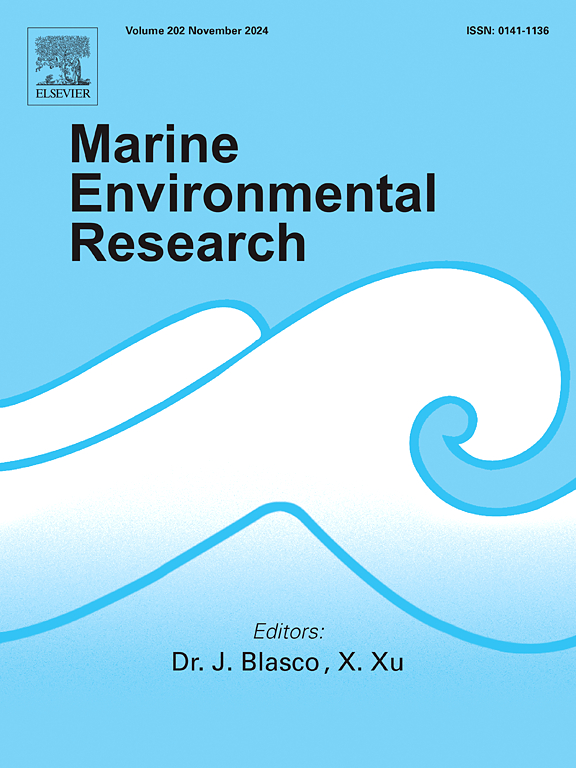Distribution and species richness of seagrass meadows in the Sea of Marmara
IF 3
3区 环境科学与生态学
Q2 ENVIRONMENTAL SCIENCES
引用次数: 0
Abstract
Comprehensive data on seagrass distribution and species richness in the Sea of Marmara (SoM) are absent from global seagrass mapping, hindering long-term monitoring and practical protection efforts for these vital meadows. This study aims to assess the species richness, spatial distribution patterns, and fundamental ecological aspects of seagrass meadows in the SoM, which serves as a crucial transition zone between the Black Sea and the Mediterranean Sea. The data set was obtained through a series of underwater surveys conducted between June and September 2024 at 140 surveyed stations, covering a total area of about 0.534 km2. Spatial and species-specific surface area (m2), cover percentage (%), and depth limits (m) of seagrass meadows were estimated from underwater records collected along line transects. Seagrass meadows constituted 51.9 % of the area surveyed in the SoM, covering an area of 0.277 km2. Results revealed a rich diversity of seagrass species within the SoM, identifying four species: Cymodocea nodosa, Posidonia oceanica, Zostera marina, and Z. noltei. C. nodosa was the most common species, occupying 82.8 % (0.230 km2) of the total surface area. The lower depth limits of seagrasses in the SoM were shallower than in other Mediterranean regions, with P. oceanica at 15.7 m and C. nodosa at 11.1 m. This limitation attributed to reductions in light penetration caused by high primary production and excessive pollution loads in the SoM. In conclusion, this dataset includes the first underwater observation-based mapping and identification of new areas for seagrass species in the SoM, contributing to distribution maps for the Mediterranean basin.

马尔马拉海海草草甸分布及物种丰富度
全球海草制图缺乏马尔马拉海海草分布和物种丰富度的综合数据,阻碍了对这些重要草甸的长期监测和实际保护工作。本研究旨在评估黑海和地中海之间重要过渡带SoM海草草甸的物种丰富度、空间分布格局和基本生态方面。该数据集是通过2024年6月至9月在140个测点进行的一系列水下调查获得的,总面积约为0.534 km2。利用沿样线收集的水下记录估算了海草草甸的空间和物种比表面积(m2)、覆盖百分比(%)和深度限制(m)。海草草甸占调查面积的51.9%,面积为0.277 km2。结果表明,区内海草种类丰富,主要有Cymodocea nodosa、Posidonia oceanica、Zostera marina和Z. noltei。其中,最常见的是结缕草,占总面积的82.8% (0.230 km2)。海草的深度下限较地中海其他区域浅,其中大洋草(P. oceanica)为15.7 m,结草(C. nodosa)为11.1 m。这种限制归因于高初级产量和SoM中过度污染负荷导致的光穿透减少。总而言之,该数据集包括首次基于水下观测的测绘和识别SoM中海草物种的新区域,有助于绘制地中海盆地的分布图。
本文章由计算机程序翻译,如有差异,请以英文原文为准。
求助全文
约1分钟内获得全文
求助全文
来源期刊

Marine environmental research
环境科学-毒理学
CiteScore
5.90
自引率
3.00%
发文量
217
审稿时长
46 days
期刊介绍:
Marine Environmental Research publishes original research papers on chemical, physical, and biological interactions in the oceans and coastal waters. The journal serves as a forum for new information on biology, chemistry, and toxicology and syntheses that advance understanding of marine environmental processes.
Submission of multidisciplinary studies is encouraged. Studies that utilize experimental approaches to clarify the roles of anthropogenic and natural causes of changes in marine ecosystems are especially welcome, as are those studies that represent new developments of a theoretical or conceptual aspect of marine science. All papers published in this journal are reviewed by qualified peers prior to acceptance and publication. Examples of topics considered to be appropriate for the journal include, but are not limited to, the following:
– The extent, persistence, and consequences of change and the recovery from such change in natural marine systems
– The biochemical, physiological, and ecological consequences of contaminants to marine organisms and ecosystems
– The biogeochemistry of naturally occurring and anthropogenic substances
– Models that describe and predict the above processes
– Monitoring studies, to the extent that their results provide new information on functional processes
– Methodological papers describing improved quantitative techniques for the marine sciences.
 求助内容:
求助内容: 应助结果提醒方式:
应助结果提醒方式:


